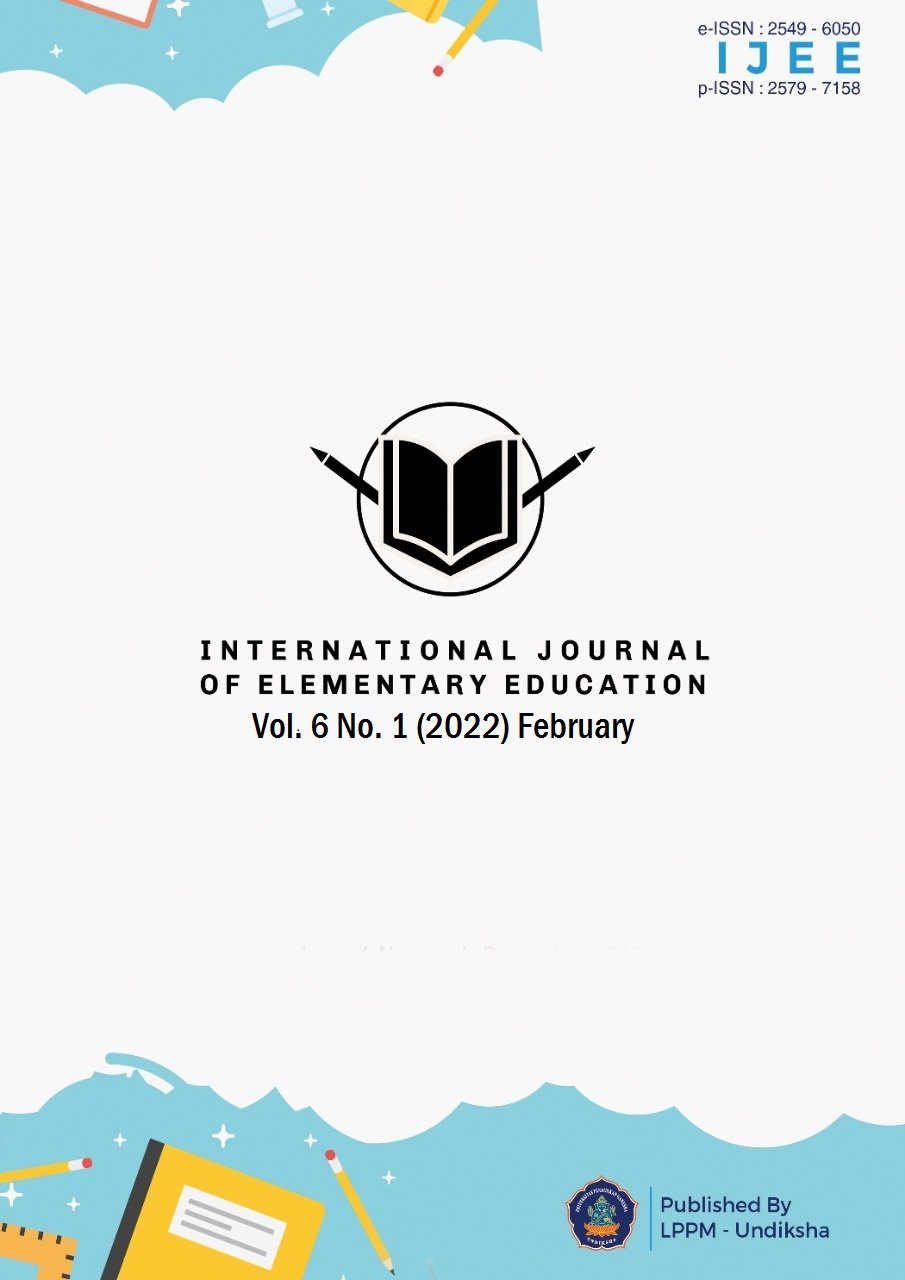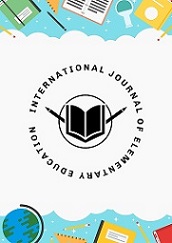Teaching English for Young Learners in Elementary School: Perceptions and Strategies
DOI:
https://doi.org/10.23887/ijee.v6i1.42013Keywords:
Teaching English for Young Learners, Perception, StrategyAbstract
Pengajaran bahasa Inggris untuk pelajar muda di Indonesia masih kontroversial di kalangan guru dan orang tua. Orang tua sangat memperhatikan kemajuan anaknya dalam berkomunikasi dan berinteraksi. Banyak kursus dan program bahasa Inggris dengan cepat menarik anak-anak dan keluarga mereka dari latar belakang kelas menengah hingga kelas atas. Pengajaran bahasa Inggris di Indonesia tampaknya memaksa siswa untuk mengetahui aturan dan mengembangkan kalimat. Selain itu, beberapa guru yang mengajar bahasa Inggris kepada siswa muda tidak memiliki pengalaman pendidikan yang sesuai untuk mengajar siswa muda. Penelitian ini dilakukan untuk menggali persepsi dan strategi dalam TEYL serta menggunakan metode kualitatif. Subyek penelitian adalah guru dan orang tua. Akibatnya, dua faktor penting harus ditangani dalam pengajaran bahasa Inggris untuk pelajar muda. Aspek pertama adalah persepsi; salah satu aspek terpenting dari pengajaran bahasa Inggris kepada pelajar muda adalah memperoleh persepsi dari orang tua dan guru. Guru dan orang tua sangat percaya bahwa semakin muda seorang anak mulai belajar bahasa Inggris, semakin banyak pengetahuan yang mereka dapatkan. Dengan nilai tertinggi pada persepsi guru yaitu 73 dari 80. Sedangkan pada persepsi orang tua nilai tertinggi diperoleh 57 dari 60. Aspek kedua adalah strategi; guru menerapkan strategi yang baik mengikuti kondisi dan situasi sekolah. Dalam hal ini, pembelajaran berbasis video adalah cara yang paling cocok untuk acara siswa, dan berisi pengembangan karakter siswa.
References
Anh, D. T. N. (2019). EFL student’s writing skills: challenges and remedies. IOSR Journal of Research & Method in Education, 9(6), 74–84. https://doi.org/10.9790/7388-0906017484.
Arif, N. (2015). Removing English as compulsory subject from primary schools on the 2013 curriculum based on teachers’. International Journal of Scientific and Research Publications, 5(8), 117–121. https://repository.unja.ac.id/1858/.
Arifin, S. (2020). The Role of Critical Reading to Promote Students’ Critical Thinking and Reading Comprehension. Jurnal Pendidikan Dan Pengajaran, 53(3), 318. https://doi.org/10.23887/jpp.v53i3.29210.
Armstrong, T. (2009). Multiple intelligences in the classroom (3rd ed.). ASCD.
Azmy, K. (2020). Examining the Issue of Abolishing English Tuition in Primary School in Indonesia. Language Research in Society, 1(1), 47–57. https://doi.org/10.33021/lrs.v1i1.1039.
Chang, Y., F. (2008). Parents attitudes toward the English education policy in Taiwan. Asia Pacific Education Review, 9(4), 423–435. https://doi.org/10.1007/BF03025660.
Chen, T. (2016). Technology-supported peer feedback in ESL/EFL writing classes: a research synthesis. Computer Assisted Language Learning, 29(2), 365–397. https://doi.org/10.1080/09588221.2014.960942.
Dixon, C., Thomson, J., & Fricke, S. (2020). Language and reading development in children learning English as an additional language in primary school in England. Journal of Research in Reading, 43(3), 309–328. https://doi.org/10.1111/1467-9817.12305.
Fahriany. (2018). Second Language Acquisition. Prenadamedia Grup.
Fauzi, C., & Basikin. (2020). The Impact of the Whole Language Approach Towards Children Early Reading and Writing in English. JPUD - Jurnal Pendidikan Usia Dini, 14(1), 87–101. https://doi.org/10.21009/JPUD.141.07.
Flyvbjerg, B. (2011). No Title. In The Sage Handbook of Qualitative Research (4th ed., pp. 301–316). Thousand Oaks.
Grigg, R. (2015). Becoming an outstanding primary school teacher (2nd ed.). Routledge.
Habibi, A., & Sofwan, M. (2015). Teachers of English for Young Learners : An Analysis on Their English Proficiency and Profile. English Education Study Program-National Semina, 1–7. https://www.academia.edu/download/46527698/EESPRON_HABIBI___SOFWAN.pdf.
Intarapanich, C. (2013). Teaching Methods , Approaches and Strategies Found in EFL Classrooms : A Case Study in Lao PDR. Procedia - Social and Behavioral Sciences, 88, 306–311. https://doi.org/10.1016/j.sbspro.2013.08.510.
Kadek, N., Listiani, M., Komang, N., Suwastini, A., Dantes, G. R., Luh, N., Sri, P., Agung, I. G., & Rwa, S. (2021). YouTube as Digital Learning Resources for Teaching Bilingual Young Learners. 540(Ictes 2020), 156–162. https://www.atlantis-press.com/article/125955262.pdf.
Kimsesiz, F. (2017). The Effect of Project Based Learning in Teaching EFL Vocabulary to Young Learners of English: The Case of Pre-School Children. Online Submission, 5(4), 426–439. https://eric.ed.gov/?id=ED581572.
Krisprasetyama, A. (2013). The role of first language in a bilingual preschool: A study in little star school, theses. Salatiga: English department faculty of language and literature. Satya Wacana Christian University.
Lie, A. (2017). English and identity in multicultural contexts: Issues, challenges, and opportunities. TEFLIN Journal, 28(1), 71–92. https://www.journal.teflin.org/index.php/journal/article/view/420.
Lightbown, P. M., & Spada, N. (2013). How languages are learned (4th ed.). Oxford University Press.
McMillan, J. H., & Schumacher, S. (2010). Research in education: Evidence-based inquiry (7th ed.). Pearson.
Nguyen, H., & Terry, D. R. (2017). English Learning Strategies among EFL Learners: A Narrative Approach. Journal of Language Learning, 3(1), 4–19. https://eric.ed.gov/?id=EJ1167252.
Nufus, T. Z. (2018). Teaching English to young learners in Indonesia (Pros and Cons). English Language in Focus (ELIF), 1(1), 65–70. https://doi.org/10.24853/elif.1.1.65-70.
Nurasiah. (2017). Teaching English to Young Learners: A Case Study at Nurul Quran Islamic School Aceh Besar. English Education Journal, 8(1), 79–97. http://www.jurnal.unsyiah.ac.id/EEJ/article/view/6130.
Pan, C., & Wu, H. (2013). The Cooperative Learning Effects on English Reading Comprehension and Learning Motivation of EFL Freshmen. English Language Teaching, 6(5), 13–27. https://doi.org/10.5539/elt.v6n5p13.
Parvin, R. H., & Salam, S. F. (2018). The Effectiveness of Using Technology in English Language Classrooms in Government Primary Schools in Bangladesh. FIRE: Forum for International Research in Education, 2(1). https://doi.org/10.18275/fire201502011049.
Peck, S. (2001). Developing Children’s Listening and Speaking im ESL. In Teaching English as a Second or Foreign Language (3rd ed., pp. 139–149). Heinle Cengage Learning.
Piaget, J. (1970). The science of education and the psychology of the child. Oxford.
Ratminingsih, N. M., Mahadewi, L., & Divayana, D. (2018). ICT-Based Interactive Game in TEYL: Teachers’ Perception, Students’ Motivation, and Achievement. International Journal of Emerging Technologies in Learning, 13(9), 190–203. https://www.learntechlib.org/p/184889/.
Remer, R., & Tzuriel, D. (2015). " I Teach Better with the Puppet " - Use of Puppet as a Mediating Tool in Kindergarten Education – an Evaluation. American Journal of Educational Research, 3(3), 356–365. https://doi.org/10.12691/education-3-3-15.
Robbins, P. S. &Timothi, A, J. (2008). PerilakuOrganisasi. SalembaEmpat.
Rosidin, U., Kadaritna, N., & Hasnunidah, N. (2019). Can argument-driven inquiry models have impact on critical thinking skills for students with differentpersonality types? Cakrawala Pendidikan, 38(3), 511–526. https://doi.org/10.21831/cp.v38i3.24725.
Schulz, M. M. (2009). Effective writing assessment and instruction for young english Language Learners. Early Childhood Education Journal, 37(1), 57–62. https://doi.org/10.1007/s10643-009-0317-0.
Shen, M., & Chiu, T. (2019). EFL Learners’ English Speaking Difficulties and Strategy Use. Education and Linguistics Research, 5(2), 88. https://doi.org/10.5296/elr.v5i2.15333.
Si, P. (2019). A Study of the Differences between EFL and ESL for English Classroom Teaching in China. IRA International Journal of Education and Multidisciplinary Studies, 15(32). https://doi.org/10.21013/jems.v15.n1 .p4.
Supriyanti, N. (2012). Challenges in providing trainings for English teachers of elementary schools. Journal of Education and Learning (EduLearn), 6(3), 161–166. http://edulearn.intelektual.org/index.php/EduLearn/article/view/159.
Syed, M., & Nelson, S. C. (2015). Guidelines for establishing reliability when coding narrative data. Emerging Adulthood, 3(6), 375–387. https://doi.org/10.1177 /2167696815587648.
Vygotsky, L. S. (1978). Mind in society. Harvard Universtiy Press.
Xiaoyang, Y., Sidhu, G. K., & Veloo, P. K. (2018). Parents’ perspectives on school and family cooperation in primary schools: A case study in China. The Turkish Online Journal of Design, Art and Communication, 8(9), 1263–1269. https://doi.org/10.7456/1080SSE/169.
Yusuf, R. (2020). Teaching EFL Students Using Selected Media: Offline Video Taken From YouTube. Utamax : Journal of Ultimate Research and Trends in Education, 2(1), 29–33. https://doi.org/10.31849/UTAMAX.V2I1.2909.
Zein, S, M. (2017). Elementary English education in Indonesia: Policy developments, current practices, and future prospects: How has Indonesia coped with the demand for teaching English in schools? English Today, 33(1), 53–59. https://www.cambridge.org/core/services/aop-cambridge-core/content/view/S0266078416000407.
Zein, S. (2016). Pre-service education for primary school English teachers in Indonesia: policy implications. Asia Pacific Journal of Education, 36(1), 119–134. https://doi.org/10.1080/02188791.2014.961899.
Downloads
Published
How to Cite
Issue
Section
License
Copyright (c) 2022 Eza Septy Lesia, Ismail Petrus, Eryansyah

This work is licensed under a Creative Commons Attribution-ShareAlike 4.0 International License.
Authors who publish with the International Journal of Elementary Education agree to the following terms:
- Authors retain copyright and grant the journal the right of first publication with the work simultaneously licensed under a Creative Commons Attribution License (CC BY-SA 4.0) that allows others to share the work with an acknowledgment of the work's authorship and initial publication in this journal.
- Authors are able to enter into separate, additional contractual arrangements for the non-exclusive distribution of the journal's published version of the work (e.g., post it to an institutional repository or publish it in a book), with an acknowledgment of its initial publication in this journal.
- Authors are permitted and encouraged to post their work online (e.g., in institutional repositories or on their website) prior to and during the submission process, as it can lead to productive exchanges, as well as earlier and greater citation of published work. (See The Effect of Open Access)










